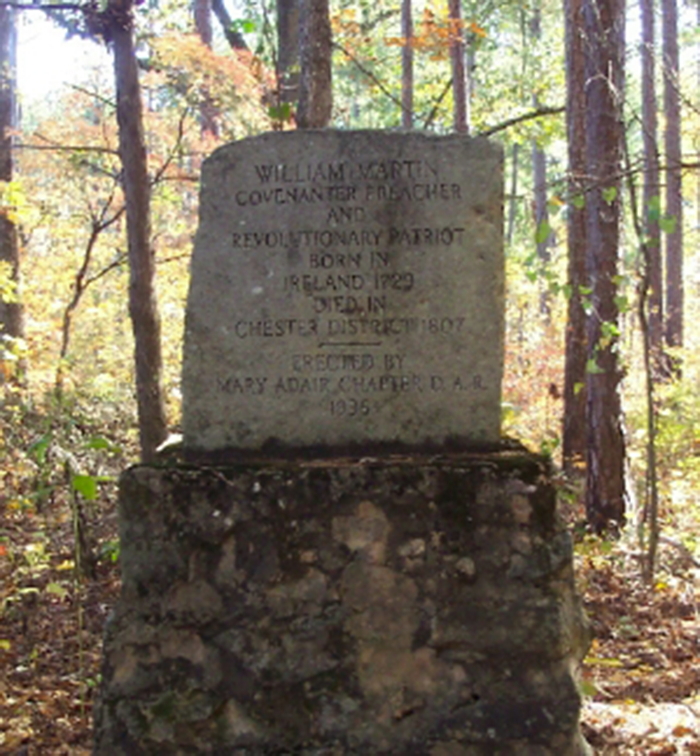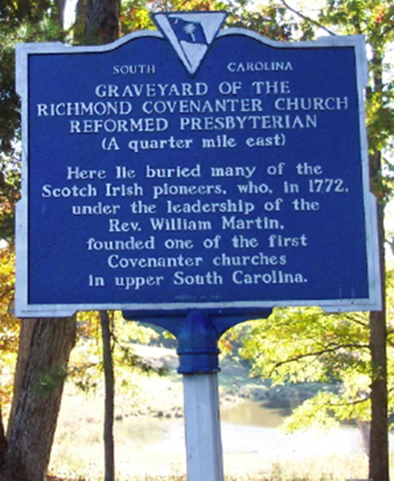Reverend William Martin
William Martin was born at Ballyspollum, near Ballykelly, County Londonderry, Ireland on 16 May 1729. On 2 July 1757, he was ordained a Covenanter minister in an open air service held at The Vow, between Ballymoney and Kilrea, County Antrim. As the only Covenanter minister in Antrim and Down, the two counties became his parish, so to speak, and Rev. Martin, though resident at Kellswater, had supervisory responsibility for Covenanter groups at Ballymoney, Dervock, Cloughmills, Leighmore and Cullybackey. Rev.
View boydroots.net in a larger map
William Martin was no shrinking violet. On top of his mammoth preaching and pastoral duties, he was vocal in his opposition to the High Church (Anglican) authorities who openly discriminated against the Presbyterians. The oppressed Presbyterians were subjected to excessive rent demands and when payment could not made, the tenants were evicted. During this period, many agents were active in Northern Ireland, representing that South Carolina was offering a bounty to settlers. Many of the poor and oppressed Scots-Irish had migrated to South Carolina. It was during this time that Rev. Martin “received a call to Rocky Creek”, a small settlement in South Carolina.
In Rocky Creek, South Carolina, there were about five or six Presbyterian groups including Associate, Covenanter, Burgher, Anti-Burgher, and Seceders. These groups combined to build a church on Rocky Mount Road, about 15 miles southeast of Chester. They called the Church “Catholic” indicating that all of the various groups were to worship there. By 1770, the Covenanters wrote to Ireland requesting that a minister be sent to South Carolina. It was probably in response to this call that Rev. Martin decided to go to South Carolina.
The traditional story is that there many incidences of violence resulting from the conflict caused by the high rents and evictions. Following one such incident, Rev. Martin preached a sermon calling for his entire congregation to accompany him to South Carolina. In 1772, a total of 4671 families responded to Rev. Martin's call to South Carolina and around twelve hundred Covenanters and others, including Roman Catholics, left Ulster under the leadership of Rev. Martin. A total of 5 ships took the emigrants to the New Country.
- The James and Mary, departed Larne on 25 August 1772 and arrived in Charleston on 18 October 1772.
- The Lord Dunluce, sailed from Larne on October 4 and arrived in Charleston on December 20.
- The Pennsylvania Farmer, sailed from Belfast on October 16 and arrived in Charleston on December 19.
- The Hopewell, sailed from Belfast on October 19 and arrived in Charleston on December 22.
- The Free Mason, sailed from Newry on 27 October and arrived in Charleston on December 19.


Most of those on board the ships came from Ballymoney, Kilraughts, Derrykeighan, Ballyrashane, the Vow and Kellswater. It was a tremendous feat at that time to lead so many people so far in such vessels yet this only goes to illustrate the determination of Rev. William Martin. Upon arrival in South Carolina, Rev. Martin, settled in Rocky Creek, where he both received a land grant and bought an additional 640 acres (1 square mile) and built a stone house. He preached regularly at Catholic, but in 1774 the Covenanter congregation withdrew from Catholic and built a log church about 2 miles east of the Catholic Church. Although, due to the excessive numbers involved, the large group that had arrived with Rev. Martin, was scattered throughout the province, the majority did manage to settle in and around Rocky Creek.
When the Revolutionary war broke out, Rev. Martin was a strong supporter of the patriots. In 1780 he preached another of his fiery sermons, reminding the congregation of the hardships that their fathers had suffered, that they had been forced out of Scotland and again out of Ireland, had come to America where they were free men and where they had built their homes and church. Now the British were coming and would once again drive them from their homes. He told them that there is a time to pray and a time to fight and the time to fight had come. Immediately after the sermon, two companies were formed under command of Ben Land and Captain Barbour. The next day they joined the American forces fighting the British. For his efforts, the British burned the church and took Rev. Martin prisoner.
On June 29, 2007, a ceremony was held at the Vow in Ireland to commemorate the 250th anniversary of the ordination of William Martin, the first Covenanter (Reformed Presbyterian) minister in Ireland. A plaque was erected at the old Vow graveyard.
The Ships and Their Passengers
There do not exist today actual passenger lists of those who arrived on the five ships with Rev. William Martin. There are, however, two sources from which a reasonable list of the heads of households can be constructed. The first is that it was the custom for passengers to write a letter expressing their appreciation to the captain of the vessel and these letters were published in a newspaper in the city of departure. Generally, all of the passengers (meaning the heads of households) signed these letters. Such letters from two of the ships were published in the Belfast News and copies are available today. These two ships were the James and Mary and the Lord Dunluce. The second and more complete source for a list of the passengers is the Council Journal (official records of the Governor's Council) in which the new Irish immigrants petitioned for land. For those who were granted land, the Council Journal records their names and the amount of land to be granted. This, of course, leaves out any passengers who purchased land, as well as all of the other family members who were not granted land directly. To some extent, the size of the household can be determined from the amount of land granted, since there was a fixed formula of 100 acres for the head of the household and 50 acres for each dependent, wife or child under sixteen. The children sixteen or over probably applied for their own land as a single head of household. This method is not precise, because some people did not apply for the full amount of land that they were entitled to. This may have been because they had the money to purchase already improved land from previous immigrants or perhaps they were tradesmen (weaver, smith or storekeeper) and only took enough land to provide for their immediate family.
It is interesting to note that in many cases, it appears that a large family with several children over 16 arrived and that not only the head of the household, but some or all of the children 16 or over also received land. This can be identified where the same surname appears several times together, with one person receiving several hundred acres of land (corresponding to a family) and the other persons with the same surname all received 100 acres (corresponding to a single person).
A complete list of the passengers as reconstructed from the Council Journal records is here (pdf). Some passengers of particular interest to the subject of this book are highlighted in bold in the appendix and are listed here.
- James and Mary: William Boyd, #381, arrived with his wife Mary Dorman and two daughters Mary and Martha and settled in Newberry District.
- Lord Dunluce: David McQuestion [sic], #54 and James McQuestion [sic], #55 are the ancestors of the McQuistons that lived in Tipton County. Specifically, David McQuiston is the GG Grandfather of Bessie McLaughlin Simonton Boyd.
- Pennsylvania Farmer: David McCreight, #253; William McCreight, #254; David McCreight, #255 and James McCreight, #268. The first of these McCreights is the father of the other three. William McCreight is the GGG Grandfather of Bessie McLaughlin Simonton Boyd (Fannie McLaughlin Simonton, Mary Ann McCreight, John R. McCreight, Robert McCreight, William McCreight). William arrived in South Carolina with his wife and 5 children.
- Other surnames that appear in the Boyd genealogy (but need more research) are:
- McDill (Pennsylvania Farmer and James and Mary
- Wilson (Lord Dunluce, James and Mary, Free Mason)
- Miller ( Lord Dunluce, Pennsylvania Farmer, James and Mary)
- Thomson (Lord Dunluce, James and Mary, Free Mason)
- Strong (Lord Dunluce)
The five ships were:
- Lord Dunluce: 400 tons, Master, James Gillis, agent, John Montgomery, merchant, Rev. William Martin, William Barklie, - 184 families, 394 persons
- Hopewell: 250 tons, Master J. Ash, agent William Beatty, merchant. The Hopewell arrived in England from South Carolina on June 16 and advertised that a minister was urgently needed in South Carolina. - 63 Families, 186 persons
- Pennsylvania Farmer: 350 tons, Master C. Robinson, agent John Ewing, S. Brown merchants. - 86 families, 215 persons
- James and Mary: a 200 ton snow, master J. Workman, agents Jams McVicker, John Moore, - 80 Families, 175 persons
- Free Mason: 250 tons, Master John Semple, agent, J W & G. Glenry, Hill Wilson, George Anderson, William Booth, merchants and owners. 55 Families; 232 persons
Scotland | Ireland | Presbyterian Church | Rev. William Martin
